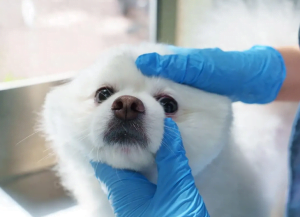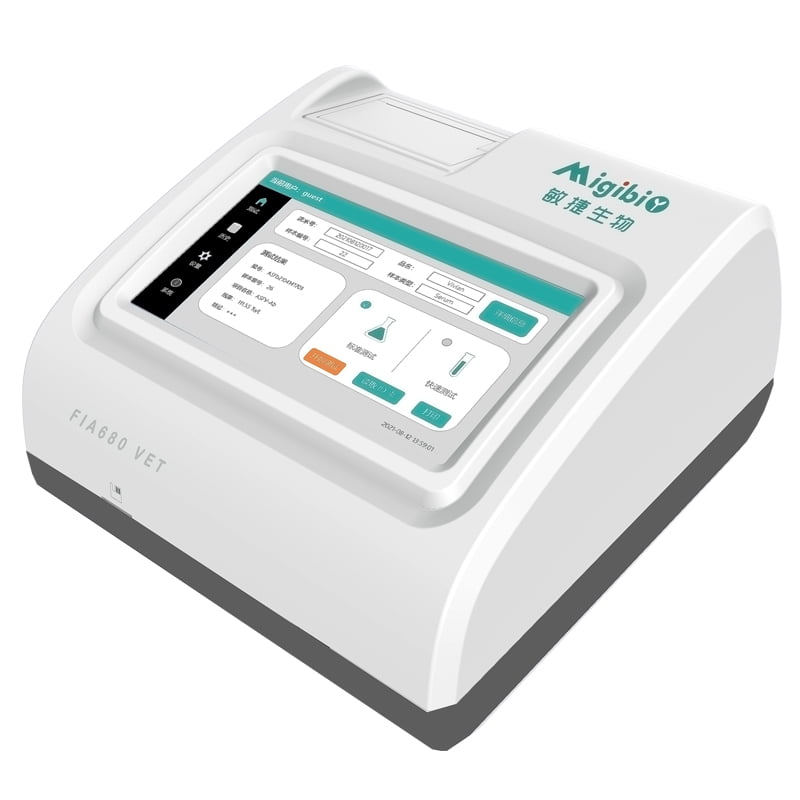In the realm of pet diagnosis, three primary technologies are commonly employed: time-resolved immunofluorescence chromatography (TR-IF), colored latex microsphere immunochromatography (CLM), and colloidal gold immunochromatography (CGIA). Each method offers unique advantages and disadvantages, making it crucial to understand their distinctions to select the most appropriate test for your pet’s specific needs.
Donc, there are questions you may ask, tel que:
- What are the advantages and disadvantages of each of them?
- Which approach is ideal?
- Which product is best to choose for pet diagnosis?
We will explore the diagnosis technologies for dogs and cats to find out the answers.

What is Time-resolved immunofluorescence chromatography (TR-IF)
Driven by technological advancements, immunochromatographic assays (ICAs) in the field of rapid diagnostics have undergone a remarkable transformation, progressing from the first-generation colloidal gold and colored latex formats to the second-generation fluorescent microsphere technology. This evolution has enabled a significant leap from qualitative to quantitative analysis.
Time-resolved fluorescence immunochromatographic (TR-FIA) technology has taken this advancement a step further, dramatically enhancing the sensitivity, précision, and precision of rapid testing.
The third-generation time-resolved fluorescence immunochromatographic technology is a novel non-radioactive rapid immunoassay technique built upon traditional fluorescence analysis. It boasts the following unique features:
- Rapid Quantitative Analysis: Employing lanthanide element europium (Eu3+)-encapsulated fluorescent microspheres as markers, the technology determines results by analyzing the fluorescence intensity in the detection and control zones, enabling rapid quantitative analysis.
- Time-Resolved Performance: The fluorescence decay time of Eu3+ is exceptionally long, reaching 714ms, compared to less than 100ms for ordinary fluorescence. By utilizing instrument-specific settings, Eu3+’s specific fluorescence signal can be isolated.
- High Relative Specific Activity: The long decay time of Eu3+ allows for repeated excitation, resulting in a high relative specific activity of the fluorescent marker.
- Wavelength-Resolved Performance: Eu3+ exhibits a large Stokes shift of 255nm, effectively eliminating interference from non-specific fluorescence, and significantly enhancing assay specificity.
- Covalent Binding: During immunolabeling, Eu3+ is covalently linked to large molecules such as antigens and antibodies, forming a stable and irreversible bond.
- Avantages: The technology offers a range of notable advantages, including ease of operation, haute sensibilité, accurate quantification, excellent precision, and high throughput, making it suitable for therapeutic efficacy monitoring and epidemic surveillance.
- Applications: The technology is particularly well-suited for disease detection, customs quarantine, and agricultural applications, where rapid results and high assay accuracy are crucial.
What is Colored latex microsphere immunochromatography (CLM)
Immunochromatographic assays (ICAs) have gained widespread recognition in various fields, including clinical diagnostics, food and drug testing, pesticide detection, antigen-antibody interactions, and animal disease diagnosis. The development of ICAs is driven by three key goals: enhancing assay sensitivity, enabling quantitative analysis, and facilitating multiplexed detection.
Colored microsphere-based ICAs have emerged as a significant advancement in the realm of ICAs, offering enhanced sensitivity and improved visual clarity, making results easier to interpret. Here are the key features of colored microsphere-based ICAs:
Superior Sensitivity: Colored microspheres serve as a superior alternative to colloidal gold, offering enhanced sensitivity for a wider range of analytes.
Internal Dyeing Technology: The internal dyeing process ensures vibrant and durable colors, preventing dye leaching from the microsphere surface, and facilitating efficient coupling with antibodies or antigens.
Hydrophilic Surface and Abundant Functional Groups: The hydrophilic surface and high density of functional groups on colored microspheres enhance their protein binding capacity, leading to improved assay performance.
Scalable Production and Consistent Performance: Colored microspheres can be produced on a large scale with consistent performance, enabling the production of up to 100 liters per batch.
Uniform Microsphere Size: Colored microspheres exhibit exceptional uniformity in size, with a coefficient of variation (CV) below 5% for regular particle sizes, minimizing batch-to-batch variability.
Customizable Design: Colored microspheres can be tailored to specific requirements, with adjustable particle size (ranging from 100 nm to 10 µm), surface functional group density, and a wide range of rainbow-inspired colors.
why colored microspheres are considered a superior alternative
| Fonctionnalité | Colloidal Gold | Colored Microspheres |
|---|---|---|
| Visibility | Bien | Excellent |
| Color | Typically red | Variety of colors |
| Color Intensity | Purplish, somewhat dull | Vibrant, easy to observe |
| Multiplexed Detection | Difficult to achieve | Easily achievable |
| Sensibilité | Generally lower | Generally better |
| La stabilité | Bien | Excellent |
| Ease of Preparation | Relatively simple | More complex |
| Preparation Reproducibility | Bien | Excellent |
| Scalability | Easy to scale up production | Very easy to scale up production |
| Labeling Method | Relatively simple | More complex |
| Purification Method | Relatively simple | More complex |
| Production Cost | Relatively inexpensive | Slightly more expensive |

